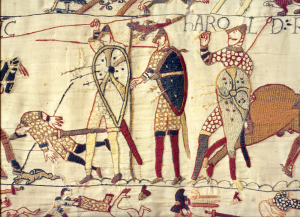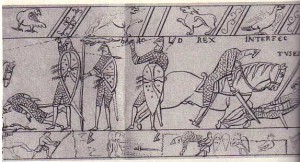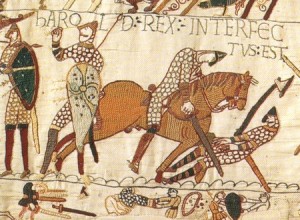The Dual Death of Harold II August 16, 2010
Author: Beach Combing | in : Medieval , trackbackBeachcombing had an argument at dinner tonight about the Battle of Hastings and the fate of the Anglo-Saxon battle leader Harold (c. 1022-1066) and wants to get rid of his angst.
Hastings, 1066, was, of course, the battle with which British history begins (or, according to a minority opinion, ends). William soon to be Conqueror (aka ‘the Bastard’) and a series of Normans, Bretons and Flems arrived on the south coast of Britain to enforce William’s dubious claim to the English throne. And King Harold II of England – someone else with a dubious claim – brought his army from the north and met William at Senlac Hill near Hastings to decide the matter in a contest of arms.
There are probably no three hours in European history that matter more: certainly the rest of British history pivot on them.
In a close run, thunderous melee Harold was killed and William’s cavalry overran the Anglo-Saxon lines. William’s rule in the country was cemented by Christmas and, despite claims to the contrary by Anglo-Saxon loving academics, his rule would never be convincingly challenged.
Beachcombing’s argument was not about whether or not Harold survived the battle. That old if thoroughly enjoyable chestnut expresses the despair of the Anglo-Saxons in the next generation rather than historical fact.
The argument was, instead, about how Harold died.
Two traditions survive: the first that Harold was cut down by Norman knights and the second that Harold was hit by an arrow in the face or eye. Confusingly both these traditions were in circulation in the generation after the battle.
The most influential (though not the most reliable) source for Harold’s fate is the Bayeux Tapestry that might have been created within ten years of the battle. The picture that heads the present post is taken from that work and seems to show Harold (see the name above the figure) with an arrow in his eye that he is attempting to remove.
Beachcombing particularly enjoys this explanation: probably for the unscientific reason that an Anglo-Saxon king dying from an arrow like Baldr – the unluckiest god in Norse mythology – would be rather poetic. He also knows that accounts of the arrow in Harold’s face were surfacing as early as 1080 in the Monte Cassino chronicle of Amatus with his excellent Norman contacts.
But there is an argument that the ‘arrow’ in the tapestry is a nineteenth-century addition. Certainly, these final parts of the tapestry were ‘redone’ after being damaged, as were some of the initial panels. We have sketches from the early eighteenth century that show the arrow puller with an object in his hand. But here the figure, it is suggesed, does not seem to be pulling an arrow out of his eye. Rather he seems to be holding a spear or part of a (broken?) spear. The following image dates to the 1730s and can be explored in more detail (in relation to other pictures) at this excellent external site.
Many have argued that Harold is actually the figure to the left of the ‘arrow’ holder. There we see an Anglo-Saxon being cut down by a Norman knight. Stepping back and looking at the tapestry this is an attractive explanation as ‘killed’ in Latin (‘interfectus est’) is over the falling man.
Beachcombing would take the compromise and put his sparse money on both figures being Harold. The dual tradition of an arrow in the face – Beachcombing suspects it is an arrow notwithstanding the arguments about restoration – and the cavalry chopping Harold down are both attested early and are perhaps both true.
The Bayeux Tapestry gives us then a cartoon like sequence to explain Harold’s death. Whether or not the makers of the Bayeux Tapestry were stitching the truth is, of course, another question…
In any case, Beachcombing hopes that Harold’s death was tolerably quick.





